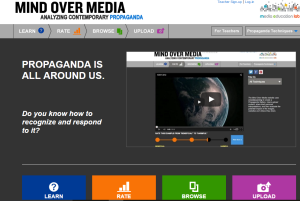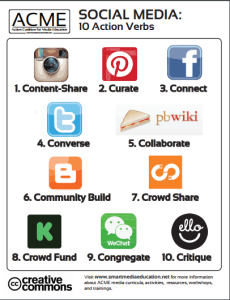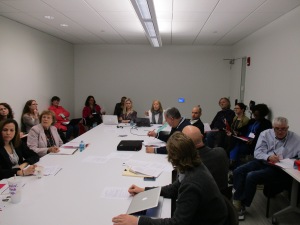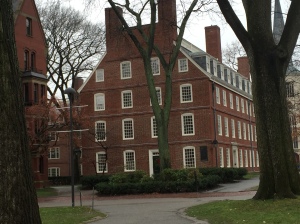I admit it, readily and happily: I’ve been an advocate of media literacy instruction since the late 1990s, when I came face-to-face with students who just didn’t want to read the required Western canon. Students would locate and share copies of Spark Notes and, without blinking, recite plot points and character distinctions. Yet, when I pulled out magazines and asked students to identify images that had parallel themes to A Separate Peace or Flowers for Algernon, they were hooked and genuinely engaged in learning.
I knew I was onto something significant with media literacy.
Now, two decades later, I’m ready to end full-time public school teaching. With closure comes insight into the progress we have made toward infusing media literacy and popular culture as part of what Giroux calls “serious academic discourse” (1989). I’m also keenly aware that challenges continue to exist and daunt the most insightful and progressive media educators, even with the seeming ubiquity of digital tools and resources.
Looking Back at Two Decades of Media Literacy in the Classroom
 Much of my grounding in media literacy (and, later, digital culture) was framed by Dr. Renee Hobbs of the Media Education Lab. Through Renee’s influence, I came to understand media literacy analysis from the early Know TV Curriculum; then it was onto analyzing advertisements, copyright and fair use, news bias, one-minute teen films, and, most recently, propaganda through Mind over Media which curates a majority of its collection from users. My students contributed, linked, and critiqued ads surrounding Dove Soap and parallel ads pointing to the destruction of South Asian rain forests, among others.
Much of my grounding in media literacy (and, later, digital culture) was framed by Dr. Renee Hobbs of the Media Education Lab. Through Renee’s influence, I came to understand media literacy analysis from the early Know TV Curriculum; then it was onto analyzing advertisements, copyright and fair use, news bias, one-minute teen films, and, most recently, propaganda through Mind over Media which curates a majority of its collection from users. My students contributed, linked, and critiqued ads surrounding Dove Soap and parallel ads pointing to the destruction of South Asian rain forests, among others.
I also learned about the National Alliance for Media Literacy Education (NAMLE) and their analysis categories of author and audience, representations and reality, and meanings and messages. That framework jump-started me and helped me to create my own deconstruction model for students, called the Visual Analysis Protocol. Regardless of the course I teach — which can range from Children’s Literature, Sports and Popular Culture, Masculinity and Sport, The Art of Film, Conspiracy Theory, or American Literature — my students have the requirement to analyze media texts incorporating a social justice lens and then to compose their own media texts.
The importance of original composing can’t be overlooked: students assume critical distance from texts and persuasion when, instead of consuming, they produce. The shift to production requires them to design within commonly accepted conventions of a genre and with clear language expression. This is tough work for any age group, but it’s essential for teens, whose identity experiences have been formed through constant media influences. Media composition also helps students to recognize the narratives employed in mainstream media texts, alongside their associative values, as a necessary step in questioning the dominant culture.
Add in “Digital” to Media Literacy Education, and What Happens in the Classroom?
As my years of teaching continued, an evolution toward 1-to-1 technology devices was slowly occurring. I was eager to move from familiar print text and paper-and-pencil literacy practices to on-demand online inquiry and digital multimodal text sets.

Digital applications have changed my pedagogy and the way that students engage with texts. I am both a teacher and digital media literacy curriculum designer, and in both roles I have reminded myself to be conscious of several pedagogical components of digital media literacy education. It is important:
- to engage students in media literacy learning in ways that foster their currency in companion digital skills and strategies;
- to develop instructional experiences that connect youths’ in-school and out-of-school literacy and learning;
- to offer inquiry into topics that arouse youth passions so to guide them as they become more deeply literate;
- to balance opportunities for analysis with original composition so that critical examination is lessens negativity and reductionism;
- and, to think of media literacy as a socially inclusive approach which calls upon civic participation and lifelong learning.
Tying It All Together in a Common Language of Digital Media Literacy
At the spring, 2016 conference sponsored by the Action Coalition for Media Education (ACME), co-president Julia Freschette outlined how digital distribution adds to consumer-generated content in a change to the entire digital landscape. She argued that the end goal now of digital media education is to understand the means through which communication is created, deployed, used, and shared. Sacred Heart University’s Director of the Master’s Degree Program in Media Literacy and Digital Culture, Bill Yousman, extended that discussion to reinforce how, even in a digital age, critical media literacy continues to deal with issues of power, and such power arises when media messages benefit dominant social groups at the cost of underrepresented groups.

Source: ACME
ACME co-president Rob Williams outlined a series of ways that a critical digital media classroom can also help students to identify how the social media environment fosters skills that apply to the real world. Yes, social media offers teens the opportunities to create and curate their own identities. But, with teens’ average 7 hours, 40 minutes per day of total media submersion — not including multimedia tasking— teens can also use social media for larger purposes. Williams suggested that educators help students to gain language to discuss what they are doing on/ with social media, which can leverage them to gain the power of the network with their particular set of skill strategies.
In a conference session titled “Global Media Literacy Education: Teaching Beyond Borders,” by Belinda De Abreau and Melda N. Yildiz, critical digital media literacy goals pointed to “global competence,” or the capacity and disposition to understand and act on issues of global significance. To gain global competence, we can recognize cultural nuances among people around us as a beginning place to examine mediated environments and topics from culturally different points of view. A companion classroom activity compares newspaper representations of specific topics through a site like NewspaperMap and ask why different interpretations of the same text occur culturally.
 Project Censored director Mickey Huff described some of that organization’s earliest instructional activities, in which students identified the stories were being covered by independent news organizations but not being disseminated by the mainstream media. They asked, “Why is there such a discrepancy?” Today, Project Censored also teaches students about logical fallacies through news headlines, and they play “Déjà Vu” when news outlets do pick up and report a previously absent story. Huff and co-author Andy Lee Roth recently published the book Censored 2016, which captures the top censored stories and media analysis of 2014-2015. Huff stated that, until we have a news system that is diverse, we need to engage in such critical media analysis.
Project Censored director Mickey Huff described some of that organization’s earliest instructional activities, in which students identified the stories were being covered by independent news organizations but not being disseminated by the mainstream media. They asked, “Why is there such a discrepancy?” Today, Project Censored also teaches students about logical fallacies through news headlines, and they play “Déjà Vu” when news outlets do pick up and report a previously absent story. Huff and co-author Andy Lee Roth recently published the book Censored 2016, which captures the top censored stories and media analysis of 2014-2015. Huff stated that, until we have a news system that is diverse, we need to engage in such critical media analysis.
Sut Jhally, Professor of Communication at the University of Massachusetts and founder and Executive Director of the Media Education Foundation, was absolutely mesmerizing as the culminating keynote speaker at the ACME conference! He revisited Neil Postman’s Amusing Ourselves to Death introduction and argued that both Orwell and Huxley were right: fear and pleasure are driving our current worlds. Jhally suggested that we read not McLuhan but McLuhan’s mentor, Henry Innis, who describes the essential influences of empire on society. Jhally also spoke of New York Times‘ Chris Hedges, who has a new book, Empire of Illusion. In it, Hedges discusses “the triviality of American popular culture… the mindlessness that makes the magic….” I’ve added lots of material to my summer reading list as a result of hearing Jhally speak.
 And, in my own presentation, Reaching Magazines that Reach Us, I argued that media images of athletes of color reproduce generational stereotypes, and, through digital media analysis, we can help students to transcend such embedded messaging. Anytime we reproduce images from a former generation for a new generation, we expose youth to another framework with which to know their worlds. If we are to assist our students become active advocates for equity in the world, we must, instead, empower them to speak as systemic reformers. Digital media literacy can offer students the skills and structures to organize and act on a larger scale in order to change laws, policy, and larger social conditions. With digital media literacy analysis, they can, in turn, educate each other about racism. Through digital media literacy, we can help students to gain tools to transform institutions for justice for all. Advocating for equitable images is one way.
And, in my own presentation, Reaching Magazines that Reach Us, I argued that media images of athletes of color reproduce generational stereotypes, and, through digital media analysis, we can help students to transcend such embedded messaging. Anytime we reproduce images from a former generation for a new generation, we expose youth to another framework with which to know their worlds. If we are to assist our students become active advocates for equity in the world, we must, instead, empower them to speak as systemic reformers. Digital media literacy can offer students the skills and structures to organize and act on a larger scale in order to change laws, policy, and larger social conditions. With digital media literacy analysis, they can, in turn, educate each other about racism. Through digital media literacy, we can help students to gain tools to transform institutions for justice for all. Advocating for equitable images is one way.
Barriers to Full Access to Digital Media Literacy Education in the U.S.
Of course, there are many issues when considering full implementation of digital media literacy programs in U.S. schools and other U.S. cultural sites. A tendency seems to exist in many professional development programs to emphasize digital tools without focusing on the more important learning application of those tools. Moreover, instructors who lack the technology expertise cannot fully utilize the potential of digital media education, and, additionally, teachers can feel compelled to choose preparation for high-stakes testing over digital media production projects.
 In June 2013, President Obama announced his ConnectED initiative, which aimed to equip practically every school in the country with a high-speed broadband connection by 2018. We often speak about ubiquitous digital access, but it is important to remember that not all individuals, schools, or cultural institutions have the capacity to offer free wireless or to supply personal technology devices to their constituents, especially in an on-needed basis. Indeed, according to the Pew Internet & American Life Project, the affluent and educated are still the most likely to have good access to digital resources.
In June 2013, President Obama announced his ConnectED initiative, which aimed to equip practically every school in the country with a high-speed broadband connection by 2018. We often speak about ubiquitous digital access, but it is important to remember that not all individuals, schools, or cultural institutions have the capacity to offer free wireless or to supply personal technology devices to their constituents, especially in an on-needed basis. Indeed, according to the Pew Internet & American Life Project, the affluent and educated are still the most likely to have good access to digital resources.
And, finally, we have to remember that the U.S. is one of the very few Western countries that does not mandate media literacy education in its public schools. Canada has media literacy requirements for their K-12 students. Countries like Sweden, Finland, South Africa, and the U.K. have some form of media literacy education for primary and secondary students. In fact, 70 to 80 percent of all European students receive some media literacy training by the time they graduate high school. If we want to teach our youth to be informed citizens in a democracy, the U.S. needs to reconsider its blatant disregard for the place and importance of digital media literacy instruction and to implement curricular standards that require students to analyze and interpret the vast amount of information that we all encounter every day.
An informed citizenry may depend on it.
Carolyn Fortuna, Ph.D. is the recipient of the International Literacy Association’s 2015 Grand Prize Award for Technology and Reading. She has a twenty year background in public school teaching, and she is a part-time faculty member in the Gender and Women’s Studies Department at Rhode Island College. If you’d like information about workshops in digital and media literacy and learning, contact Carolyn at c4tuna31@gmail.com.
Resources
Freire, P. and Giroux, H. (1989). Pedagogy, popular culture, and public life: An introduction. In Popular culture: Schooling and everyday life. Eds. H. Giroux and R. Simon. New York, NY. Bergin & Garvey Publishers, Inc.






 Intrigued by “the cultural, political, and economic relationships of sport to society” that this knowledge community embraces, I was ready to dive headfirst into a world of sport analysis.
Intrigued by “the cultural, political, and economic relationships of sport to society” that this knowledge community embraces, I was ready to dive headfirst into a world of sport analysis.

You must be logged in to post a comment.